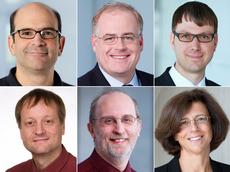Research success by the dozen
Twelve professors from ETH Zurich have received a prestigious ERC Advanced Grant from the European Research Council. Over 33 million Swiss francs will thus flow into ETH Zurich in this round of awards. ETH Life presents the winning projects in two parts.

With the Advanced Grants, the European Research Council (ERC) supports projects by established researchers. They are thus also regarded as special awards. In 2012 the ERC awarded the coveted grant to a total of 302 scientists from twenty-four different countries, twelve of whom teach and conduct research at ETH Zurich. We present the first six here in alphabetical order:
Hot on the trail of toxins
Originally from the USA, Erick M. Carreira has been a full professor of organic chemistry since 1998 and primarily specialises in the synthesis of biologically active, complex natural products. For his ERC project, he is taking on a very special natural product: toxic chlorosulpholipids, which come from mussels, for example. Carreira believes that the structure of these natural substances contains information that is closely linked to their biological activity. “The ERC funding now enables us to get to the bottom of this issue and put forward a whole series of hypotheses,” says a delighted Carreira. The ERC project involves several steps: from the structural characterisation of the chlorosulpholipids and the synthesis and examination of lipid analogs to the development of analytical methods that enable these toxins to be detected in the environment.
Networks against metabolic diseases
Forty-four-year-old Martin Fussenegger is a professor of biotechnology and bioengineering at the Department of Biosystems in Basel. Classic metabolic disorders such as obesity, diabetes and cardiovascular diseases can hardly be cured holistically with general pill-based drugs. In his ERC project, Fussenegger would like to further the development of networks that function like a kind of prosthesis in the body and consist of genetic circuits. The implanted networks measure and monitor blood sugar and blood fat, for instance, process these values and coordinate the production of therapeutic proteins until the normal values in the body have been reached again. With the ERC project, Fussenegger would like to “achieve successes quickly in basic medical research and test the networks in clinical trials as soon as possible.”
Understanding social behaviour patterns better
Unlike the Homo oeconomicus, not only does the Homo socialis make decisions that optimise his personal situation, he also takes the expectations of other people into consideration. Although social man is of enormous interest, as yet there is no consistent fundamental theory of social systems. A professor of sociology since 2007, Dirk Helbing would like to change this with his ERC project. “The ERC grant provides the critical weight that successful research requires. Now we can tackle the project without having to submit a new grant application every couple of months,” says Helbing. In the project, the interactions between individuals are to be modelled with the aid of an agent-based simulation. The agents in the project should be equipped with cognitive skills and the modelling approach also contains complex elements such as self-organisation, emergence and adaptation. Ultimately, the project should reveal how social behaviour patterns and norms come about.
Fluid-structure systems for the future
“For me, the ERC grant is recognition of the work my team at ETH Zurich has done in recent years,” says Hans Jürgen Herrmann, a theoretical physicist and professor at the Institute for Building Materials. His project focuses on fluid-structure systems. An example: a garden hose moves when water flows through it. In general, the fluid deforms the elastic hollow space it flows through, which in turn influences the flow. Furthermore, the fluid can also alter the properties of the walls, such as in blood vessels. The aim of the project is the efficient numerical calculation of such fluid-structure systems with very large deformations and, if need be, also growth. This can also be used for electron flows. They could make nanometric semiconductor bridges oscillate, from which tiny scales or switches, so-called NEMS (nano-electromechanical systems), are to be produced in future.
Customised protein capsules
Fifty-seven-year-old American Donald Hilvert is a professor at the Laboratory of Organic Chemistry. His group has been concerned with the design of proteins for years. Many proteins form regular, bowl-like hollow bodies, so-called capsids, which play a key role as molecular transporters. The research team is planning to customise capsids for the selective absorption of different objects to enable them to transport medication or contrast agents for medical imaging procedures easily. Moreover, the researchers are planning to develop a series of artificial nanoreactors using capsids: one is supposed to fix carbon dioxide like plants, another be able to convert different alcohols and a third could break down toxic polychlorinated phenols biologically.
Basis for alternative energy sources
One attosecond is a trillionth of a second (10-18) – an inconceivably short amount of time. Ursula Keller has been a professor of experimental physics since 1993 and conducts research on these ultra-short time dimensions. Her toolbox includes an atto-clock, which was invented at ETH Zurich. In her project, she is looking to examine electron transfer processes with an ultra-short temporal and atomic spatial resolution. In doing so, the researcher measures how fast light can transport individual electrons away from an atom, for instance. A deeper understanding of these rapid processes forms the basis for the search for alternative energy sources, the synthesis of complex, functional medication or the development of new, electronic devices. Keller is delighted with the grant: “For me, this ERC project means more time for research, a boost for our NCCR MUST and a reward for my decision to venture into the world of attoseconds twelve years ago.”
Read part two on 6 February 2013







READER COMMENTS